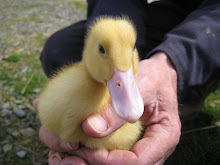 Hedging
Hedging is a complicated business. There are many opinions on it; to cut or not to cut, and if you cut, then how much and when. There are
numerous styles of laying a hedge depending on the locality, and certain approaches favour particular species of wildlife. It is verboten to neatly cut, mechanically flail, or chop indiscriminately at your hedge during the months of March through July as you would certainly disturb nesting birds, and January and February are the preferred lopping times if possible.
As the land here is, as the optimistic estate agent put it "drought resistant", it has to be done before waterlogging sets in and the tractor with its heavy flail makes irredeemable grooves in the ground, so this is the week for the cutting of selected hedges.
The hedges that were so beautifully laid last winter get a gentle trim. Those to be laid this winter are sided up to enable the hedgelayer reasonable access to his target, and across the farm about half of the hedges will get a haircut this year, allowing the rest to grow tall before it's their turn next year. Not cutting everything in one year is important for retaining diversity of habitat and to make sure I have enough blackberries for jam-making and such (no, that's not included in
cross compliance but it's important to me and anyone who visits in the expectation of chomping on scones and jam). And then there are the three hedges that have very high environmental value status - they have
dormice - which won't be touched until January or February to ensure hibernation is not curtailed. There are also a few good hedges that will be left for the foreseeable future, and are being allowed to grow big and bushy and dense.
The process of preparing for all this is not easy. All the hedgerow trees carefully planted last winter have had their high visibility orange markers checked so that they don't fall prey to the flail. Trying to do this in early autumn was a complete waste of time as leaves obscured all new planting from view, and the late leaf drop has only just revealed the young saplings. Heated debates have been had about which 50% of hedges to cut and which to leave. Even those fields that are to be left need to have their gateways trimmed so that tractors and trailers can move across the farm and I don't knock myself out as I daydream whilst walking the dogs through what my memory rather than my eyes anticipates as a gap.
Devon hedges are bizarre things, most of them being laid on top of
earthbanks. I cannot get a definitive answer as to why this is, unless Devon farms used to house particularly tall beasts that would not be contained by hedge alone. I have absurd visions of giraffe and elephant roaming these parts in medieval times when the field patterns and boundaries were determined. Someone must have the answer.
 There's been playing about in the woods the last few days. Time was getting short for coppicing so it rushed to the top of the list. It's too wet to take a vehicle down, so a barrow was piled with chainsaw, loppers, appropriate lubricants (chain oil not brandy), thick thornproof gloves, and the dogs were called and off we went.
There's been playing about in the woods the last few days. Time was getting short for coppicing so it rushed to the top of the list. It's too wet to take a vehicle down, so a barrow was piled with chainsaw, loppers, appropriate lubricants (chain oil not brandy), thick thornproof gloves, and the dogs were called and off we went.

























